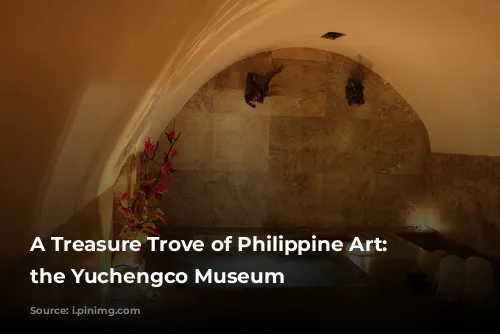Imagine a museum where you can truly immerse yourself in art, without the hustle and bustle of a crowded gallery. The Yuchengco Museum in Makati is a haven for art enthusiasts seeking a tranquil and intimate experience. It’s the perfect place to delve into the captivating world of Philippine art, where you can savor each masterpiece at your own pace.
A Glimpse into the Masters’ Canvas: Juan Luna’s Legacy
Juan Luna (1857-1899), a renowned Filipino painter who gained prominence in 19th-century Europe, left an enduring mark on the art world. He honed his skills in the classical style of painting, a training that led to masterpieces like “Spoliarium,” which earned him a prestigious gold medal at the 1884 Madrid Exposition of Arts.
The Yuchengco Museum houses two captivating canvases by Juan Luna: “Blast Furnaces of Vizcaya” and “Interior of Robert Steel Mill.” These works, commissioned by the mill owner Martinez de las Rivas, offer a glimpse into the industrial world of the time. Although Luna’s paintings often feature darker tones, the gaseous emissions from the furnaces evoke a sense of movement, reminiscent of Monet’s “Gare Saint Lazare” series, which captured the steam rising from locomotives.
Luna’s later works, influenced by the Impressionists’ lighter palettes, reflect his time spent in Paris from 1884 to 1893. “The Parisian Life (Interior d’un café)” is a prime example of this stylistic shift.
Fernando Amorsolo: Capturing the Essence of the Philippines
Fernando Amorsolo, affectionately dubbed the “Grand Old Man of Philippine Art,” was a prolific artist who produced an astonishing 10,000 works throughout his life. He masterfully captured the beauty of Philippine landscapes and the vibrant tapestry of its people, immortalizing them on his canvases.
Amorsolo’s talent wasn’t limited to landscapes; he was also a celebrated portraitist, sought after for his ability to capture the essence of his subjects. Edwin A. Martinez, in his insightful article “Amorsolo’s Sketches,” aptly described Amorsolo’s genius: “What distinguishes Amorsolo from the other great artists is that not only did he use lines to define shape but oftentimes he utilized the absence of them to suggest form.”
Botong Francisco: A Master of Mural Painting and Storytelling
Botong Francisco (1912-1969) was a true visionary, a poet who expressed his love for his land and people through his art. He earned the prestigious title of National Artist on June 12, 1973, for his extraordinary contributions to Philippine art, particularly his mastery of mural painting.
“Courtship Ritual” is a prime example of Botong’s captivating storytelling. The painting depicts a man playing a nose flute, his music seemingly lulling everyone around him, including a dog, into a state of peaceful slumber. The women, with their exposed breasts, and the man, with his muscular physique and outstretched legs, add a touch of sensuality to the scene.
“Camote* Eaters,” one of Botong’s final masterpieces, is a powerful testament to his artistry. This canvas, brimming with emotion, portrays the struggles of poverty, hunger, hardship, and perhaps even injustice, leaving a lasting impression on the viewer.
Ang Kiukok: A Fusion of Artistic Styles
Ang Hwa Shing or Ang Kiukok (1931-2005) possessed a unique artistic style that set him apart from his contemporaries. His canvases were a fusion of Cubism, Surrealism, and Expressionism, resulting in captivating works that reflected his bold and imaginative vision.
He once said in an interview that painting set him free, allowing him to express himself freely: “I can express what I want to say.” Ang Kiukok’s artistic genius was recognized in 2001 when he was bestowed the prestigious title of National Artist for the Visual Arts.
Vicente Manansala: The Pioneer of Filipino Cubism
Vicente Manansala (1910-1981) is widely regarded as the pioneer of Cubism in the Philippines. He drew inspiration from the Filipino environment, incorporating it into his paintings such as “Candle Vendors,” a striking example of his signature style.
This unique form of Cubism, known as “reinterpreted” or “indigenized” Cubism, distinguished itself by refraining from fragmenting figures into unrecognizable shapes. Manansala’s approach involved reducing figures to basic geometric forms while preserving their integrity and recognizability.
The Yuchengco Museum offers a captivating journey into the heart of Philippine art, inviting you to explore the masterpieces of renowned artists like Juan Luna, Fernando Amorsolo, Botong Francisco, Ang Kiukok, and Vicente Manansala. It’s a place where you can discover the rich tapestry of Filipino culture and immerse yourself in the beauty of their artistic expressions.
